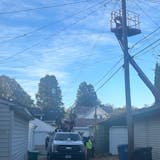I stood on the boat's back deck, gripping the tiller and peering down at lambs and ewes grazing in green pastures far below me. Pigeons flew beneath the boat and soared across the misty blue hills. "Sheep ahoy," shouted the captain beside me. An answering "Aye aye" came from the distant bow as our crew rushed to look over the side.
It was early autumn. My wife, Barb, and I, with two Scottish friends, were cruising Britain's Llangollen Canal in rural England and Wales. We had rented a classic narrowboat, which was providing both transportation and housing for the week. Now we were steering our boat through a thousand-foot water channel, crossing high above the Dee River valley on the largest aqueduct in the United Kingdom. Behind us spread the rolling farmlands of Shropshire; ahead rose the Welsh mountains. And far, far below us a flock of sheep was ignoring our nautical passage overhead.
Barb and I, and our friends Ruth and Jimmy, had no experience operating a boat. Anywhere. The thought of navigating our elongated houseboat through myriad locks, tunnels and aqueducts was daunting — even more so when our boat hire company spent only a few minutes "orienting" us before handing over the keys.
"Don't worry," the man assured us, "in a week you'll be experts."
What saved us was the leisurely pace on the canal. Top speed on U.K. canals is a mere 4 miles per hour, and most of the time we kept our boat's diesel engine quietly chugging through the verdant countryside at a slow crawl. The tow path, originally intended for horses who pulled 19th-century barges up and down the canal, is now a public recreation trail popular with strollers and bicyclists. In fact, on our first cautious day of cruising, we were overtaken by an elderly gentleman with a cane, limping along the canal-side path and eventually disappearing into the distance ahead.
At such low speeds on narrow canals, collisions are common but seldom do damage. In our first afternoon afloat, we managed to run aground in midstream, scrape several bridge abutments and collide with a tree. No matter. The sturdy craft are like fairground "bumper boats," bouncing gently off canal banks, tunnel walls, even other watercraft. Every narrowboat we saw carried the inevitable scars, for most of the traffic on the Llangollen canal was piloted by vacationing landlubbers as inexperienced as ourselves.
A quirky houseboat
Finding our way was easy. A map from Heron Maps, Ltd., showed everything from aqueducts, locks, bridges and overnight mooring places to historic sites and — perhaps most important — pub locations. Cruising slowly against the 1-mph current, we had ample time to commune with herds of curious cows and unimpressed sheep in pastures along the banks, while noisy mallards and wild cranes took flight at our approach. Jimmy and I took turns being "captain" at the tiller; Barb and Ruth — our genuine first mates — sat up in the bow, watching for approaching traffic as we steered around bends, through tunnels and under bridges.
We barely traveled a mile up the canal that first day, mooring for the night alongside a country inn. Ruth and Barb brewed tea in the galley and brought it up on deck where Jimmy and I were playing guitar and English concertina. Another boat tied up near us, its crew coming over to enjoy the music; they invited us into the pub for a few friendly pints, and we all had dinner together.

